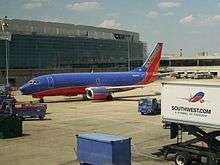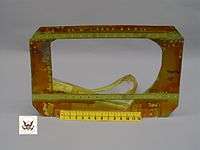Southwest Airlines Flight 2294
 N387SW, the aircraft involved in the incident, photographed in 2008 at Philadelphia International Airport. | |
| Incident summary | |
|---|---|
| Date | July 13, 2009 |
| Summary |
In-flight structural failure Rapid decompression |
| Site | near Charleston, WV |
| Passengers | 126 |
| Crew | 5 |
| Fatalities | 0 |
| Injuries (non-fatal) | 0 |
| Survivors | 131 (all) |
| Aircraft type | Boeing 737-3H4 |
| Operator | Southwest Airlines |
| Registration | N387SW |
| Flight origin | Nashville International Airport (KBNA) |
| Destination | Baltimore Washington International Airport (KBWI) |
Southwest Airlines Flight 2294 (SWA 2294, WN 2294) was a scheduled US passenger aircraft flight which made an emergency landing at Yeager Airport (CRW) in Charleston, West Virginia, on July 13, 2009, after suffering a rapid depressurization of the passenger cabin. The aircraft landed safely with no fatalities or major injuries to passengers and crew. An NTSB investigation found that the incident was caused by a failure in the fuselage skin due to metal fatigue.[1]
Incident

The aircraft involved was a Boeing 737-3H4 N387SW,[2] serial number 26602, operating a scheduled flight between Nashville, Tennessee (KBNA), and Baltimore, Maryland (KBWI).[3] The aircraft took off and climbed for about 25 minutes, leveling off at a cruising altitude of approximately 35,000 feet (11,000 m).[1] At about 5:45 pm Eastern Standard Time, the cabin altitude warning activated in the cockpit, indicating a dangerous drop in cabin pressure. The captain disengaged the autopilot and began an emergency descent to bring the aircraft down into denser air to prevent passenger hypoxia. The cabin altitude alarm ceased as the aircraft passed through about 9,000 feet (2,700 m). The flight crew then landed the aircraft safely at CRW. After landing, the aircraft was found to have a three-sided hole in the fuselage, 17.4 inches (44 cm) long, and between 8.6 to 11.5 inches (22–29 cm) wide, forward of the leading edge of the vertical stabilizer, at the rear end of the aircraft.[1]
Investigation
The accident was investigated by the Federal Aviation Administration (FAA) and the National Transportation Safety Board (NTSB). NTSB review of the cockpit voice recorder records, and post-incident interviews, showed that the flight crew acted appropriately in response to the emergency. The NTSB investigation found that the incident was caused by a metal fatigue crack in the fuselage skin. The aircraft was delivered to Southwest Airlines in June 1994, and at the time of the accident flight, had accumulated approximately 42,500 takeoff/landing cycles, and 50,500 airframe hours.[1] Highly magnified inspections found that a long metal fatigue crack had developed at the boundary of two different manufacturing processes used by Boeing in creating the fuselage crown skin assembly.[1] Boeing finite element modeling had suggested that stress forces in this boundary region are higher due to differences in stiffness, indicating that a failure was more likely to occur in this area after a certain number of pressurization-depressurization cycles. Following this incident, on September 3, 2009, Boeing issued a Service Bulletin calling for repetitive external inspections to detect any cracks in this more-vulnerable area of the fuselage skin. The FAA then followed up by issuing an Airworthiness Directive on January 12, 2010, mandating these inspection requirements.[1]
Earlier criticism of the carrier's lax maintenance and inspection practices, for which the airline had been fined $7.5 million in 2008, was quickly echoed.[4]
Less than two years later, a strikingly similar incident occurred on Southwest Airlines Flight 812, involving another Southwest Airlines Boeing 737-3H4. In response to the second incident, the FAA issued an Airworthiness Directive requiring more frequent inspections by all airlines of all Boeing 737 Classic aircraft.
References
- 1 2 3 4 5 6 "DCA09FA065". www.ntsb.gov. National Transportation Safety Board. Retrieved January 5, 2016.
- ↑ "July 2009". Jacdec. Archived from the original on August 8, 2009. Retrieved 17 September 2009.
- ↑ Shawn Nottingham and Stephanie Gallman (July 14, 2009). "Jet makes landing with football-sized hole". CNN.
- ↑ Eric Torbenson and Dave Michaels (July 15, 2009). "Hole in Southwest jet revives inspection concerns". Seattle Times.
External links
- Southwest Airlines information regarding Flight 2294, official blog
| Wikinews has related news: U.S. investigators probe in-flight hole in passenger jet |